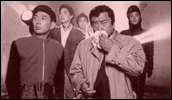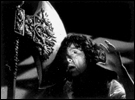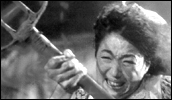Sweet Home
- Year
- 1989
- Original title
- Suito Homu
- Japanese title
- スウィートホーム
- Director
- Cast
- Running time
- 102 minutes
- Published
- 31 October 2001



by Tom Mes
According to director Kiyoshi Kurosawa, all the films he made before 1997's Cure are flawed. In the literal sense, this goes for his very entertaining 1989 haunted house film Sweet Home too. It was produced by the late Juzo Itami, who was then one of the few filmmakers to have consistent commercial success in Japan throughout the 80s, and who had collaborated with Kurosawa on a number of previous occasions (most notably as an actor in the younger director's The Excitement of the Do-Re-Mi-Fa Girl / Do-Re-Mi-Fa Musume no Chi wa Sawagu, 1985).
Itami made a number of alterations to Sweet Home after the film's theatrical run, including the reshooting and replacing of special effects scenes for the video and tv versions (Kurosawa's original version at present only exists as a film print in Toho's studio vaults). Though the result is not nearly as disastrous as these kinds of interventions usually tend to be, the film has since then often been described as being more Itami's film than Kurosawa's (who also wrote the screenplay).
Ironically, this scenario mimicked what happened to Tobe Hooper, a director long admired by Kurosawa, when he made his haunted house film Poltergeist (1982) under the productorial auspices of Steven Spielberg. Though Hooper has always denied Spielberg's involvement in the creative process aside from some assorted second unit tasks, rumours have always abounded that it was actually Spielberg who wielded the megaphone on set.
A big factor in this regressive disownment debate over Sweet Home is the fact that the film looks nothing like the deliberately paced, gloomy, cerebral chillers such as Cure and Charisma, that Kurosawa is known for today. Sweet Home takes almost the opposite approach to the genre: a colourful, action-packed, special fx-laden rollercoaster horror movie.
Starring Itami's wife and frequent star actress Nobuko Miyamoto in the lead role, Sweet Home follows the exploits of a group of people venturing to a deserted mansion to restore a priceless mural to its full splendor. Arriving at the site, they find that much of the house is covered in additional murals depicting hellish scenes of a mother losing her child in a blazing fire. When the restorer's daughter starts finding evidence that the mother and child from the paintings indeed once lived in the house, and the child's grave is discovered in the garden, evil forces are unleashed. Objects start moving seemingly by themselves and one by one the members of the team start dying gruesome deaths.
As can be judged from the synopsis, Sweet Home is hardly a shining example of cinematic innovation. Kurosawa and Itami doubtlessly went for box office appeal, resulting in a conventionally structured script echoing Robert Wise's 1963 genre milestone The Haunting (though with an interesting female-centered narrative revolving around the strength of the mother-daughter bond). Luckily they also realized that in order to pull in the crowds, they had to give audiences bang for their buck. So while all the elements and clichés of the genre are firmly in place (with Itami himself as the token hermit with the mysterious past), the thrills, chills and special effects (courtesy of American make-up fx master Dick Smith, of The Exorcist fame) come thick and fast. Kurosawa keeps the camera moving, employs fast yet effective editing, and strikes a nice balance between the use of garish colours and ominous shadows.
Despite its unsurprising plotting, Sweet Home is action-packed, thrill-packed and effects-packed, resulting in a more than entertaining haunted house ride.